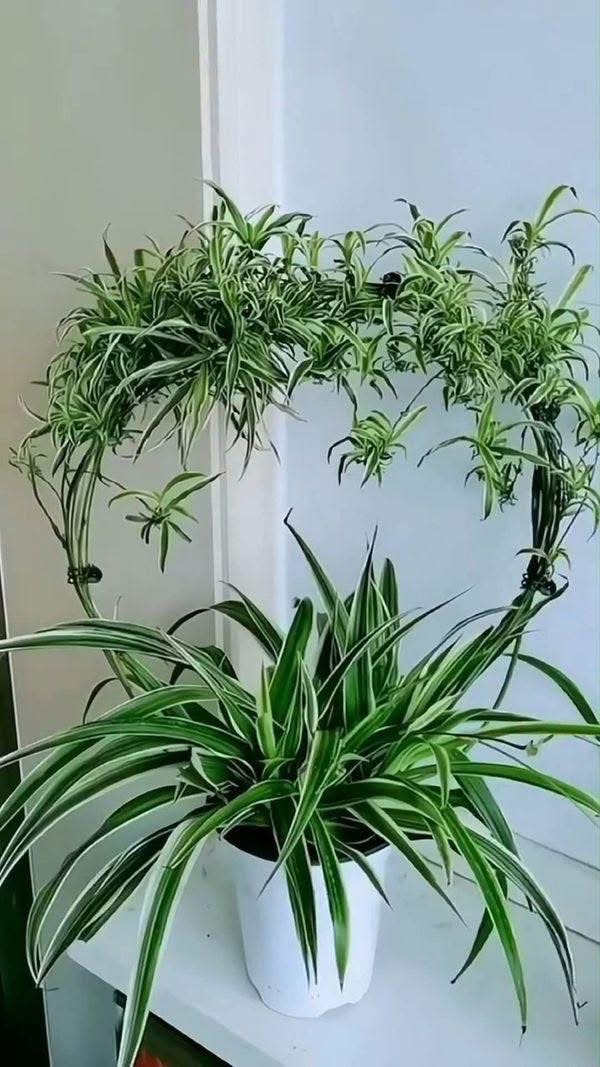
If you’re looking for a houseplant that’s both aesthetic and easy to grow, the Spider Plant (Chlorophytum comosum) should be at the top of your list. Known for its cascading leaves and adorable baby plantlets, spider plants have been a staple in homes for decades. Not only do they look stunning, but they’re also excellent air purifiers, hardy survivors, and a joy for both beginner and expert plant parents.
Let’s dive into their charm, how to grow them, and why these pictures of spider plants might just make you their biggest fan!
Why Spider Plants Are So Popular
- Air-Purifying Powerhouse – NASA’s Clean Air Study ranked spider plants as one of the best at removing toxins like carbon monoxide, benzene, and formaldehyde.
- Low Maintenance – They tolerate neglect, thrive in various light conditions, and are very forgiving if you miss a watering or two.
- Pet-Friendly – Unlike many houseplants, spider plants are non-toxic to cats and dogs (though cats often enjoy batting the dangling babies).
- Fast-Growing & Propagating – With little “spiderettes” hanging down, you can easily grow new plants from cuttings.
- Versatility in Style – They look beautiful in hanging baskets, on shelves, or in floor pots.
Types of Spider Plants (Varieties You’ll Love)
- Variegated Spider Plant – Green leaves with white stripes down the middle.
- Reverse Variegated – White edges with a green center.
- Solid Green – Classic, lush, deep green leaves.
- Bonnie Curly Spider Plant – Fun curly leaves with a playful twist.
- Zebra Spider Plant – Dark green with bold, creamy-yellow stripes.
Awesome Spider Plant Picture Inspirations
Imagine these settings for your home:
- Hanging Baskets in Sunlight – Cascading spiderettes look magical in macrame plant hangers by a sunny window.
- Spider Plants on Bookshelves – Their arching leaves soften the look of books and décor.
- Cluster of Varieties – Mix curly, variegated, and green spider plants for a lush indoor jungle corner.
- Bathroom Buddy – A spider plant thrives in humidity, making it perfect for bathrooms.
- Outdoor Patio Planters – Use them in shaded patios for a tropical vibe.
How to Grow & Care for Spider Plants
Materials You’ll Need
- Spider plant (or baby plantlet)
- Pot with drainage holes
- Well-draining potting soil (peat + perlite mix works best)
- Watering can
- Fertilizer (optional but recommended)
Step-by-Step Method: Planting & Care
1. Planting
- Choose a pot that’s 1–2 inches larger than the root ball.
- Fill halfway with well-draining potting soil.
- Place the spider plant (or baby cutting with roots) in the center.
- Cover with more soil, leaving about 1 inch from the top.
- Lightly press down and water thoroughly.
2. Light Requirements
- Prefers bright, indirect light.
- Can survive in low light, though growth will slow.
- Avoid harsh direct sun, which can scorch leaves.
3. Watering
- Water once the top inch of soil feels dry.
- Do not let roots sit in water (they’re prone to rot).
- In summer: water more frequently; in winter: reduce.
4. Temperature & Humidity
- Thrives in 18–27°C (65–80°F).
- Tolerates normal household humidity, but enjoys misting in dry air.
5. Fertilizing
- Use a balanced liquid fertilizer every 2–4 weeks during spring and summer.
- Avoid over-fertilizing, as it can cause brown leaf tips.
6. Propagation (Easy & Fun!)
- Identify baby spiderettes (offshoots) hanging from the main plant.
- Snip off once they develop small roots.
- Place in water or directly into soil.
- Within weeks, you’ll have a new thriving spider plant!
Tips for Keeping Your Spider Plant Healthy
- Brown tips? Caused by fluoride in tap water or over-fertilizing. Use filtered water if possible.
- Crowded roots? Spider plants love being slightly root-bound, but repot every 2–3 years.
- Leaf yellowing? Usually from overwatering. Let soil dry a bit between watering.
Benefits of Having Spider Plants at Home
- Improves indoor air quality naturally.
- Boosts mood and reduces stress – caring for greenery is therapeutic.
- Adds style & greenery to any space with little effort.
- Great for beginners – almost impossible to kill.
- Teaches kids gardening since they’re so easy to propagate.
Conclusion
The spider plant is more than just a decorative houseplant—it’s a symbol of resilience, simplicity, and natural beauty. Whether you choose a classic variegated variety or a curly “Bonnie,” you’ll fall in love with its playful look and effortless charm.
So, after taking a look at some of the most awesome spider plant pictures, maybe it’s time to add one (or five!) to your collection. Not only will your space look greener and fresher, but you’ll also enjoy the many benefits this plant brings into your home.
